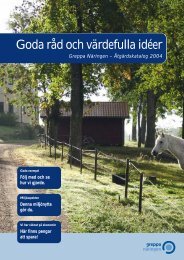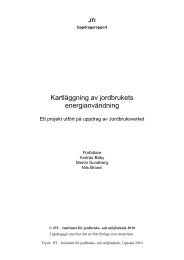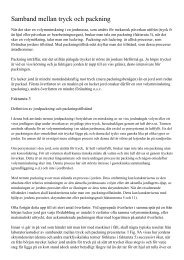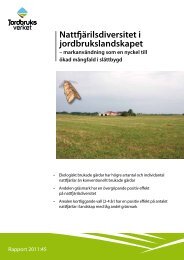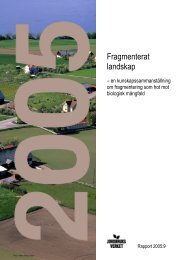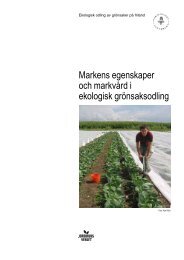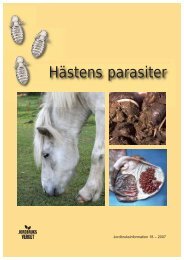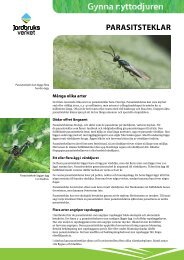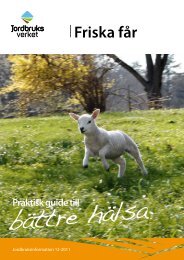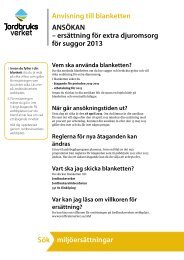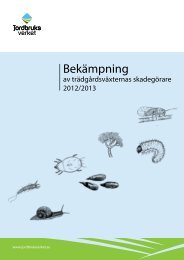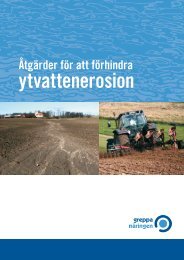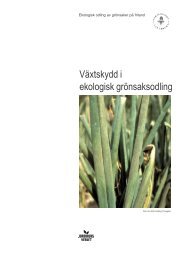Strategies for detection and delimitation surveys of ... - Jordbruksverket
Strategies for detection and delimitation surveys of ... - Jordbruksverket
Strategies for detection and delimitation surveys of ... - Jordbruksverket
Create successful ePaper yourself
Turn your PDF publications into a flip-book with our unique Google optimized e-Paper software.
6.2.6 Step 3B: Selection <strong>of</strong> survey sites if first or second sampling indicates<br />
that eradication is not an option<br />
In this case the aim is to delimit PWN-infested parts <strong>of</strong> Sweden from regions free<br />
<strong>of</strong> PWN. Since such a survey needs to include large areas it will face the same<br />
problem as described above <strong>for</strong> the <strong>detection</strong> survey (i.e. that an unrealistic high<br />
number <strong>of</strong> samples is required). Another problem is that the survey needs to be<br />
repeated because PWN may continue to spread over larger <strong>and</strong> larger areas both<br />
by vector dispersal <strong>and</strong> by human transports (Robinet et al. 2009). Thus, there<br />
should be strong arguments <strong>for</strong> starting such a survey with the aim to achieve containment.<br />
But, EU-regulations will probably require that <strong>surveys</strong> are conducted<br />
(Commission Decision 2006/133/EC, under revision).<br />
6.2.7 Organization <strong>of</strong> <strong>delimitation</strong> survey<br />
The survey plan described above is based on the existence <strong>of</strong> a contingency plan<br />
in which the maximum area <strong>of</strong> a PWN-infestation is defined <strong>for</strong> eradication to be<br />
an option. Thus, such a plan needs to be decided in the near future.<br />
The intensity <strong>of</strong> the sampling <strong>for</strong> delimiting the area <strong>of</strong> eradication or <strong>for</strong> delimiting<br />
which parts <strong>of</strong> Sweden that are infested (in case <strong>of</strong> no eradication) is<br />
dependent on which statistical level <strong>of</strong> confidence that is needed by the decision<br />
makers. It is important that this issue is h<strong>and</strong>led because it will have consequences<br />
<strong>for</strong> the resources (e.g., money, field inspectors, capacity <strong>for</strong> PWN analyses <strong>of</strong> collected<br />
samples) needed <strong>for</strong> the survey.<br />
A plan <strong>for</strong> how to recruit <strong>and</strong> educate at short notice the field inspectors required<br />
<strong>for</strong> the delimiting survey is needed.<br />
To successfully conduct the steps described above requires a tight cooperation<br />
with the Swedish Forest Agency (both at the local <strong>and</strong> central level), <strong>for</strong>est companies<br />
<strong>and</strong> private <strong>for</strong>est owners operating in the area <strong>and</strong> experts on Monochamus<br />
beetles <strong>and</strong> PWN to be able to adapt to different situations that might develop.<br />
How this should be organized needs to be planned.<br />
7. Gaps <strong>of</strong> knowledge<br />
Which are the absolute densities <strong>of</strong> Monochamus-colonized wood objects (number<br />
per ha <strong>for</strong>est l<strong>and</strong>) in different regions <strong>of</strong> Sweden? With this in<strong>for</strong>mation the proportion<br />
<strong>of</strong> wood objects sampled can be quantified <strong>and</strong> thus also the probability <strong>of</strong><br />
<strong>detection</strong> <strong>for</strong> a chosen infestation level. This in<strong>for</strong>mation is especially important<br />
during a <strong>delimitation</strong> survey. This in<strong>for</strong>mation could be retrieved by field inspections<br />
<strong>of</strong> large number <strong>of</strong> clear-cuts in different regions <strong>of</strong> Sweden. By estimating<br />
the proportion <strong>of</strong> colonized wood objects in relation to e.g. clear-cut size, tree species<br />
<strong>and</strong> other clear-cut variables simple models could be developed <strong>for</strong> estimating<br />
density <strong>of</strong> Monochamus-colonized wood objects.<br />
How many beetles will an odor-baited trap catch <strong>and</strong> in which kind <strong>of</strong> habitats<br />
should they be placed to catch the highest number <strong>of</strong> beetles (e.g. fresh clear-cuts<br />
21



